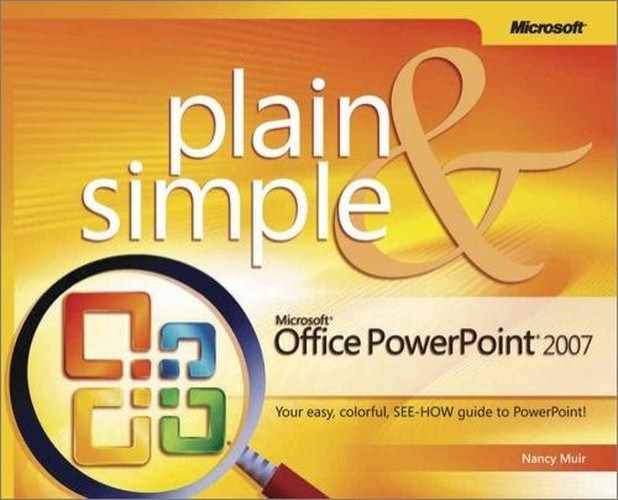In this section:
After you have built your slides, set up your slide show, rehearsed your presentation, and saved it to CD, the time comes to present your slide show to an audience. Assuming the show is set up to be given by a live presenter (see Chapter 12 for more about this setting) a presenter must know how to run the show, navigate among slides, annotate slides, and so on.
PowerPoint offers a few different ways to move around a presentation and a set of annotation tools that allows you to make notes as you present. If your presentation sparks interesting ideas, action items, or questions you need to follow up on, you can use the annotation tools to jot notes and save those annotations with your presentation. You can also switch to another program or even go online while presenting to display other kinds of documents and content.
Knowing how to use these tools can mean the difference between a smooth presentation and an awkward viewing and presenting experience.
Starting a slide show simply involves displaying the Slide Show view. This view shows your slides in full screen mode (unless you set up your show to be browsed by an individual, in which case your slides appear with a scrollbar around them). In Slide Show view, there are no speaker’s notes or tool tabs in evidence, although there is a set of presentation tools that appear in the lower right corner of the screen when you move your mouse, which you learn more about in the following two tasks.
See Also
For information about navigating among views in PowerPoint, see "Running a Presentation in Slide Show View".
See Also
To learn more about setting up your show to be browsed by individuals or run by a presenter, see "Setting Up a Slide Show".
 With a presentation running in Slide Show mode, do one of the following:
With a presentation running in Slide Show mode, do one of the following:Click Escape on your keyboard.
Click the Slide Show icon and choose End Show.
Press Ctrl+Break.
Press the hyphen key [-].
Navigate to the last slide in the presentation and press the right-arrow key on your keyboard. A black screen appears with a message that instructs you to click your mouse to end the show.
Tip
If you want to temporarily remove your presentation from the screen, you don’t have to exit the show. Instead, you can click the Slide Show icon and choose Screen and then the Black Screen or White Screen command. This is useful if you pause for a discussion and don’t want people distracted by the words and images on screen.
Tip
Did you forget how to jump to another slide or some other handy navigation shortcut? Don’t worry. Click the Slide Show icon and choose Help. A Slide Show Help window appears listing common keystroke commands. This list includes some very useful shortcuts; for example, to go to a black screen you can simply type "b".



